Seahouses Right Whale Jaw Bones
Landmark In Seahouses, Northumberland
The jaw bone of a Right Whale forming an arch, framing the harbour of Seahouses and beyond to the Farnes, with a fishy past!
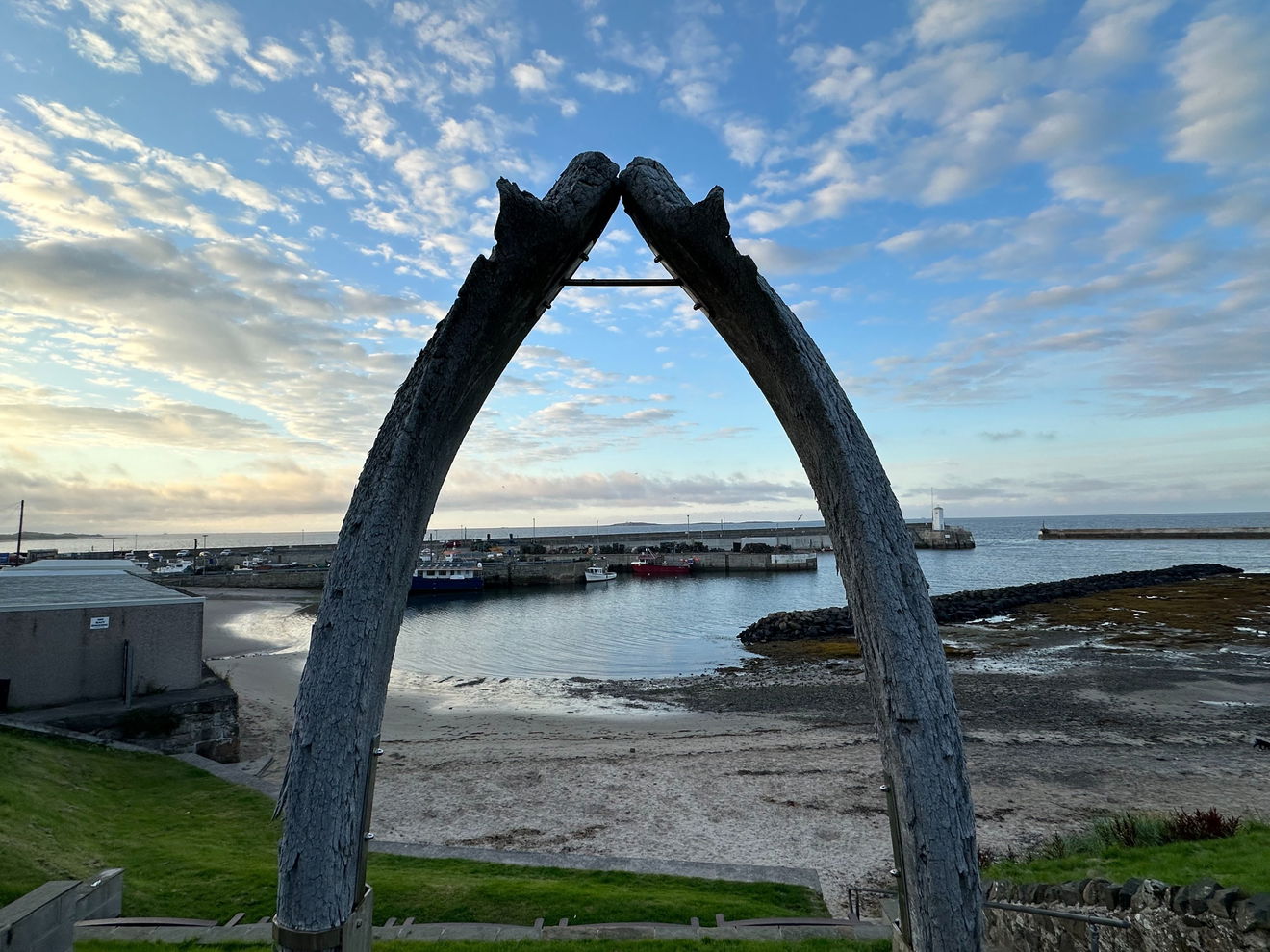
There's always new stuff to see.
After a sea spotting tea in Seahouses, instead of taking the normal, up the hill by the lifeboat station route, I hugged the harbour wall, keeping close to the sea. In ditching the chip wrappers in a bin on the bend of the road I stumbled across a jagged jaw bone of a 200 year old Right Whale, recently installed but long lived in Seahouses.
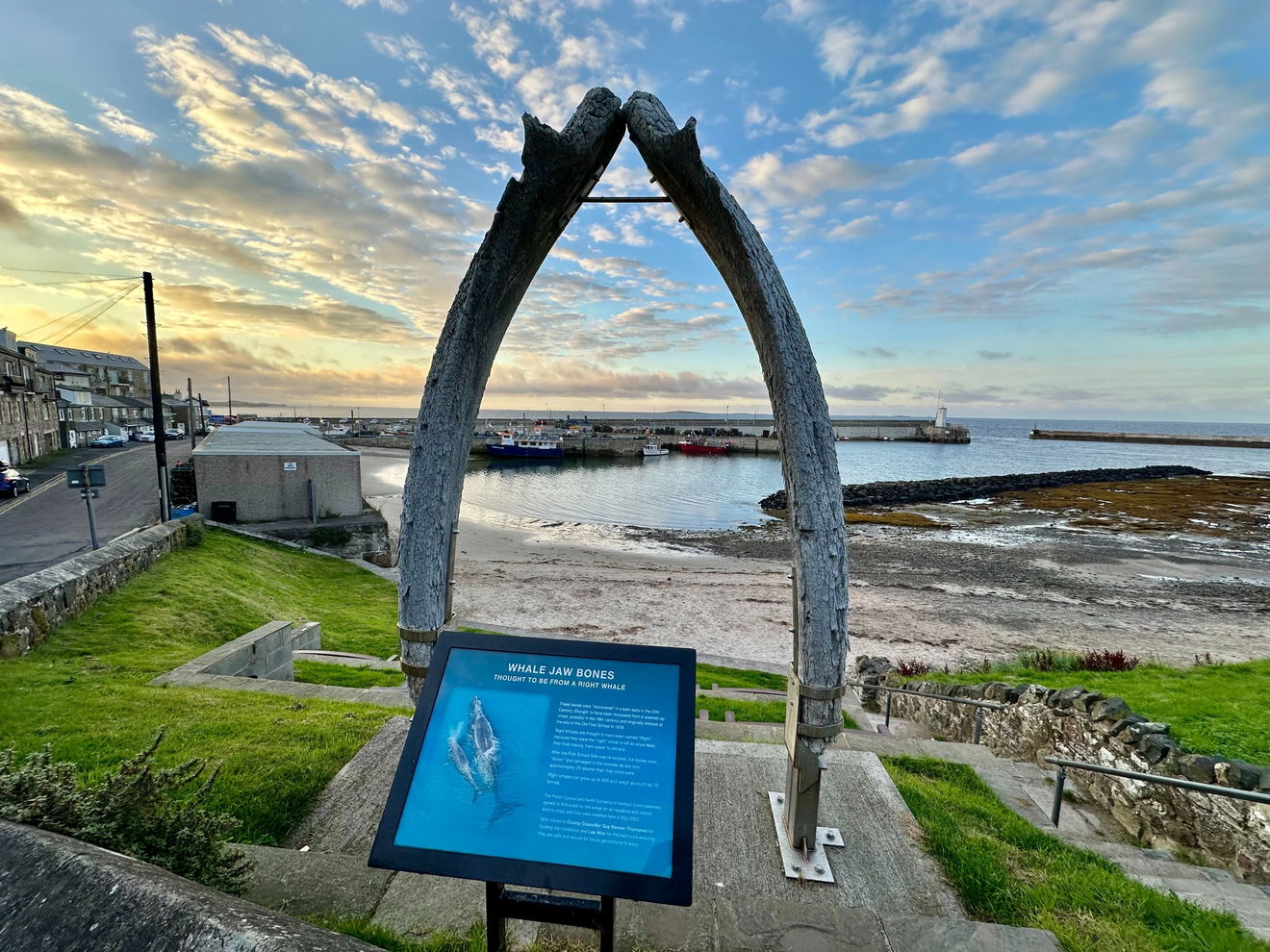
Right Whales can grow to 16 metres in length and weigh up to 70,000 kilograms. They were so named by fishermen because they were seen as 'the right whales to hunt'. These whales are slow swimming, found close to shore and therefore an easy target, with the added fact that they floated once killed, so without the need to haul them aboard a boat. They offered an abundance of oil and baleen and were hunted near to extinction until the culling of these huge mammals was officially banned in 1935. Today, there are a mere 350 left in the wild and they are under constant threat from ship collisions and from becoming entangled in fishing nets.
Scientists are keeping a close eye on this leviathan of the sea.
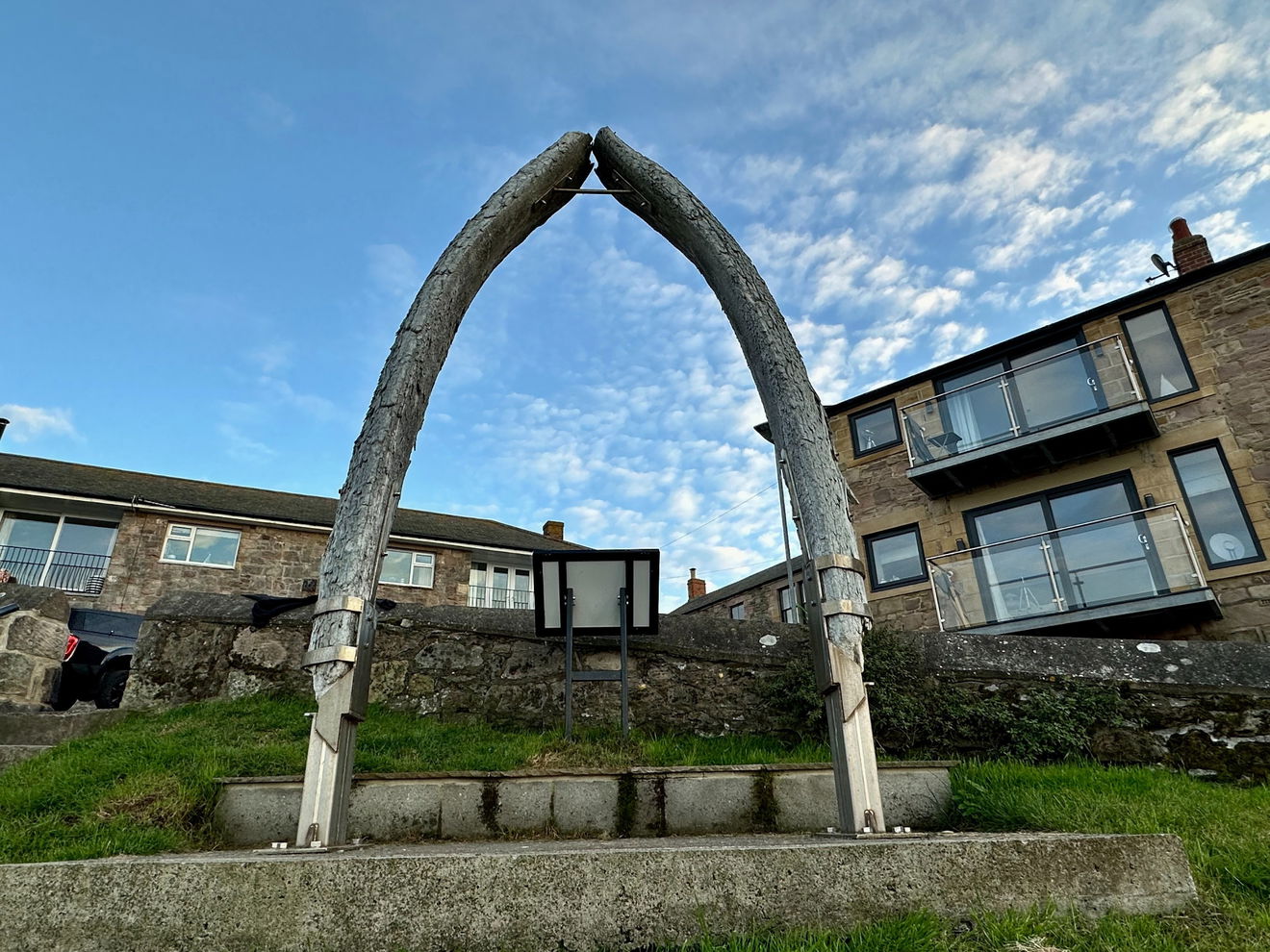
Controversial in many ways for many reasons, jaw bones are best kept in the gobs of the great whales who once owned them, and rightfully, they are a core part of the skeletal sea swimming cetaceans whose blubber hangs on them and calls them home.
However, in days gone by, in small seaside communities, whales were a key ingredient for day to day living.
For a century between 1750 and 1850, the North East was a prolific locus for whaling, and sturdy ships would set sail from Northumberland and cut through the icy waters to the Arctic. Hunting was from open boats and involved the hand-held harpooning of huge marine mammals.
Aside from meat, eaten as a source of protein, fats, vitamins, and minerals, whale baleen was like the plastic of its time. This flexible plate from its upper jaw enabled the making of corsets and collars, hoops for ladies' skirts, riding crops, baskets, hat brims and umbrella ribs.
Whale oil was used for lighting and lubrication. It helped light the lifesaving beam of Longstone Lighthouse. It was used as a base for soaps and perfumes and was even used in the making of glue to seal envelopes at one point.
I'd forgo all that to see a Right Whale for real.


Right whales are not regularly spotted in our waters however, Just days ago in August 2024, a North Atlantic Right Whale was spotted off the coast of Ireland, the first to be seen for 114 years.
So, Seahouses are the custodians of a pair of jaw bones and the controversy doesn't stop there. These are thought to be 19th century, perhaps brought to the village by a crew of returning seamen as a prize possession, maybe washed up on a northeastern saltwater shore, no one knows.
They looked rough and weather-worn and it was clear they'd been carved up, cut up and built up at points throughout their time on dry land.
They're said to date back to the early 1800s and had been hitched up in the beams of a barn belonging to farmer Walter Dunn. He gifted them to the primary school in 1938. He'd probably been a pupil here and thought their legacy would have had some integrity here.
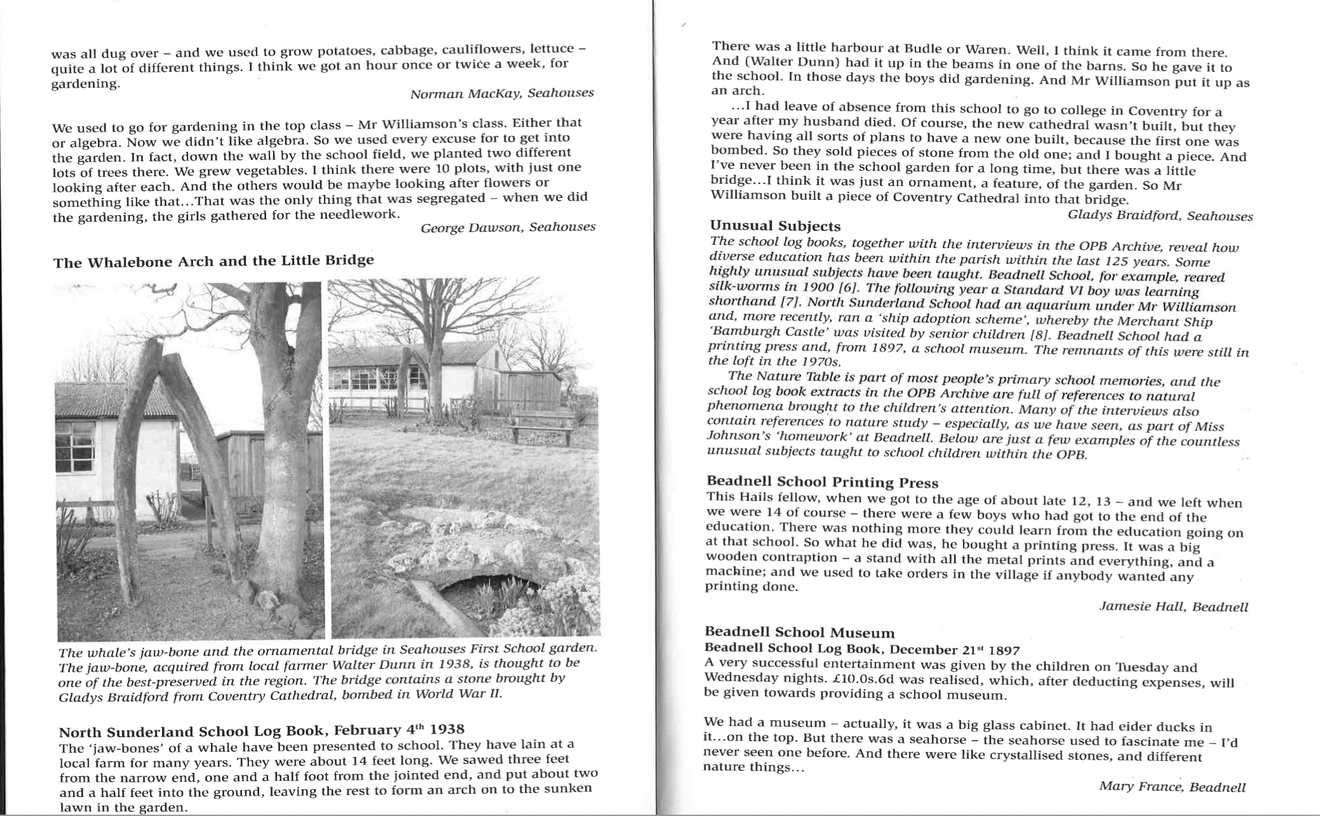
There's a lovely little passage in a local book perfectly named, 'Clarty Boots and Inky Fingers', by poet Katrina Porteous which is a history of school life in Seahouses and the surrounding villages, giving an insight into the oddity of whale bones on land in the wilds of North Sunderland, by teacher Gladys Braidford - North Sunderland Log Book, February 4th 1938.
'The jaw bones of a whale have been presented to school. They have lain at a local farm for many years. They were about 14 feet long. We sawed three feet from the narrow end, one and a half foot from the jointed end and put about two and a half feet into the ground, leaving the rest to form an arch on to the sunken lawn garden. There was a little harbour at Budle or Waren. Well, I think it came from there. And Walter Dunn had it up in the beams in one of his barns. So he gave it to the school. In those days the boys did the gardening. And Mr Williamson put it up as an arch.'
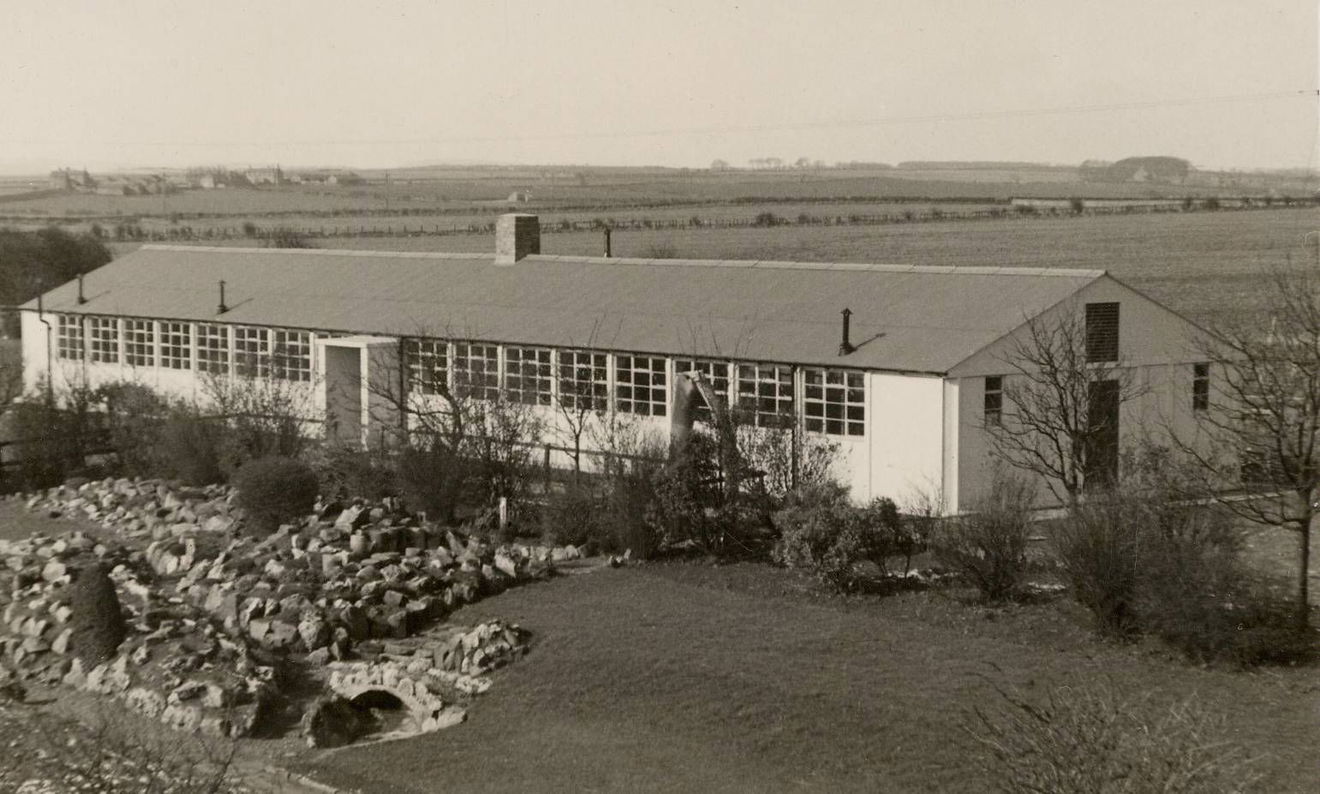
And here the plot thickens. For 80 years, the whalebone arch had pride of place in the school garden. The school relocated, and there were plans afoot to move the jawbones too, however, a discussion arose as to the suitability of the location of the bones and it was suggested that the parish council should perhaps take custody of the jaw bones and position them in a more accessible place so the wider community could enjoy them too.
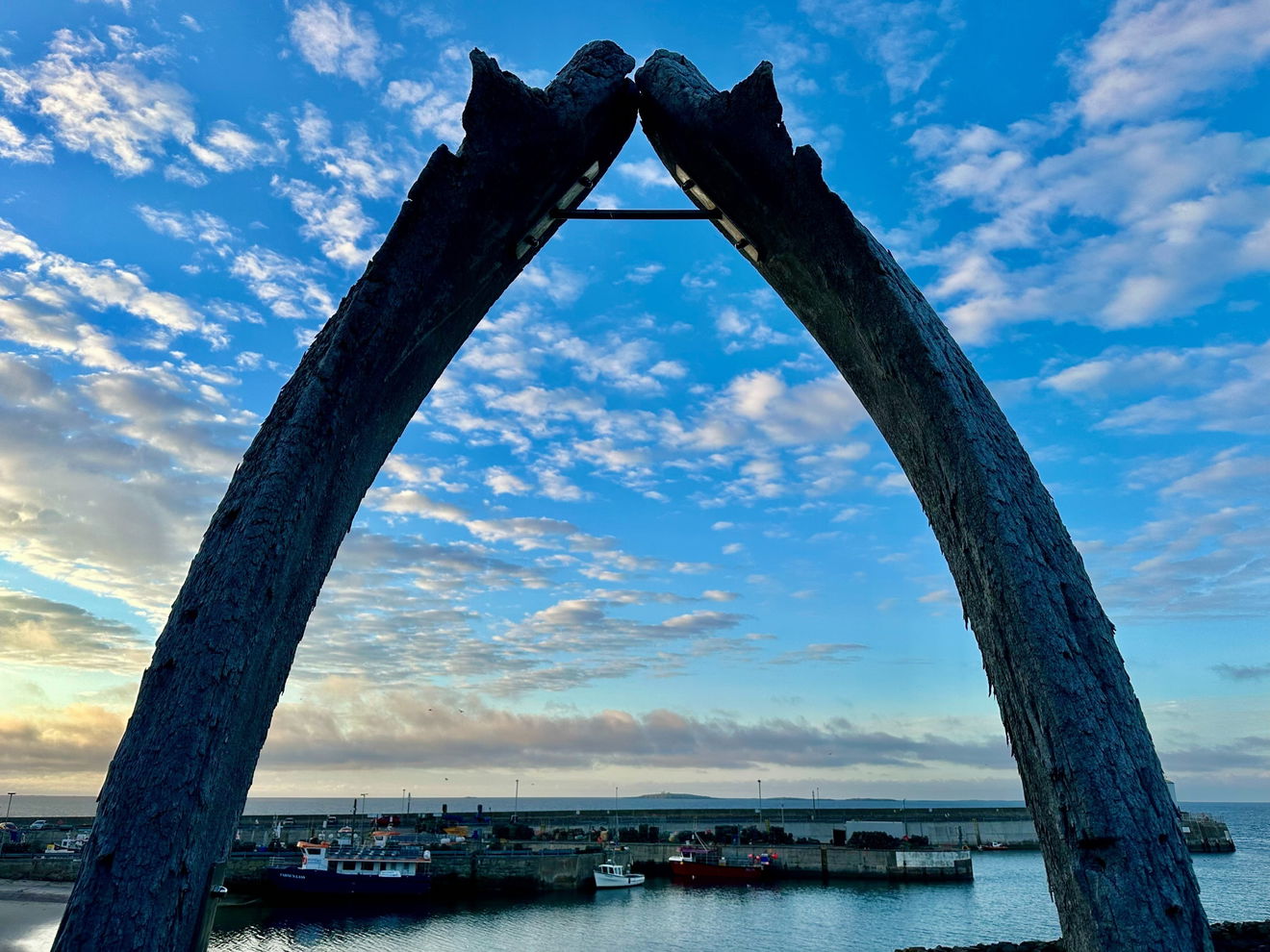
However, in a plot twist in December 2018, the jawbones vanished! A council surveyor arranged to meet a specialist removal company for a study to be carried out before the bones were relocated from the former school site and as the surveyor went to take some photos of the ancient bones, she found they had gone.
They were unceremoniously sliced from the ground and stolen! Thought to be the best and most well-preserved example of whale jaw bones in the region, the jaw went AWOL. Everyone's lips were sealed, and no one whispered a word about their whereabouts!
Some months later, the jawbones were found dumped outside the gates of North Sunderland Football Club.
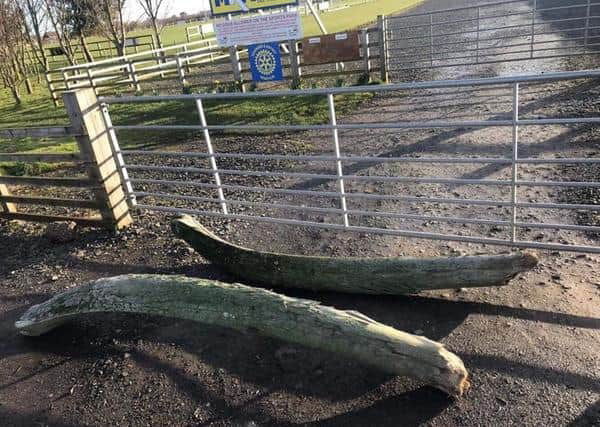
In 2023, after some lengthy too-ing and fro-ing and controversy between the first school and the council, it was decided that the whalebones should be exhibited in a public place in the harbour for the community to share.
The jaw bones could originally have stood up to five metres high and belonged to a mammal with the largest mouth of any animal. They were used as symbols of civic pride and were popular in the 1800s.
Understandably the school were sad to lose what they felt was theirs, but in the late summer sunshine, it was apparent that passers-by were enjoying the framed view of the bite of this Eubalaena glacialis from the harbour and onwards to the Farnes.
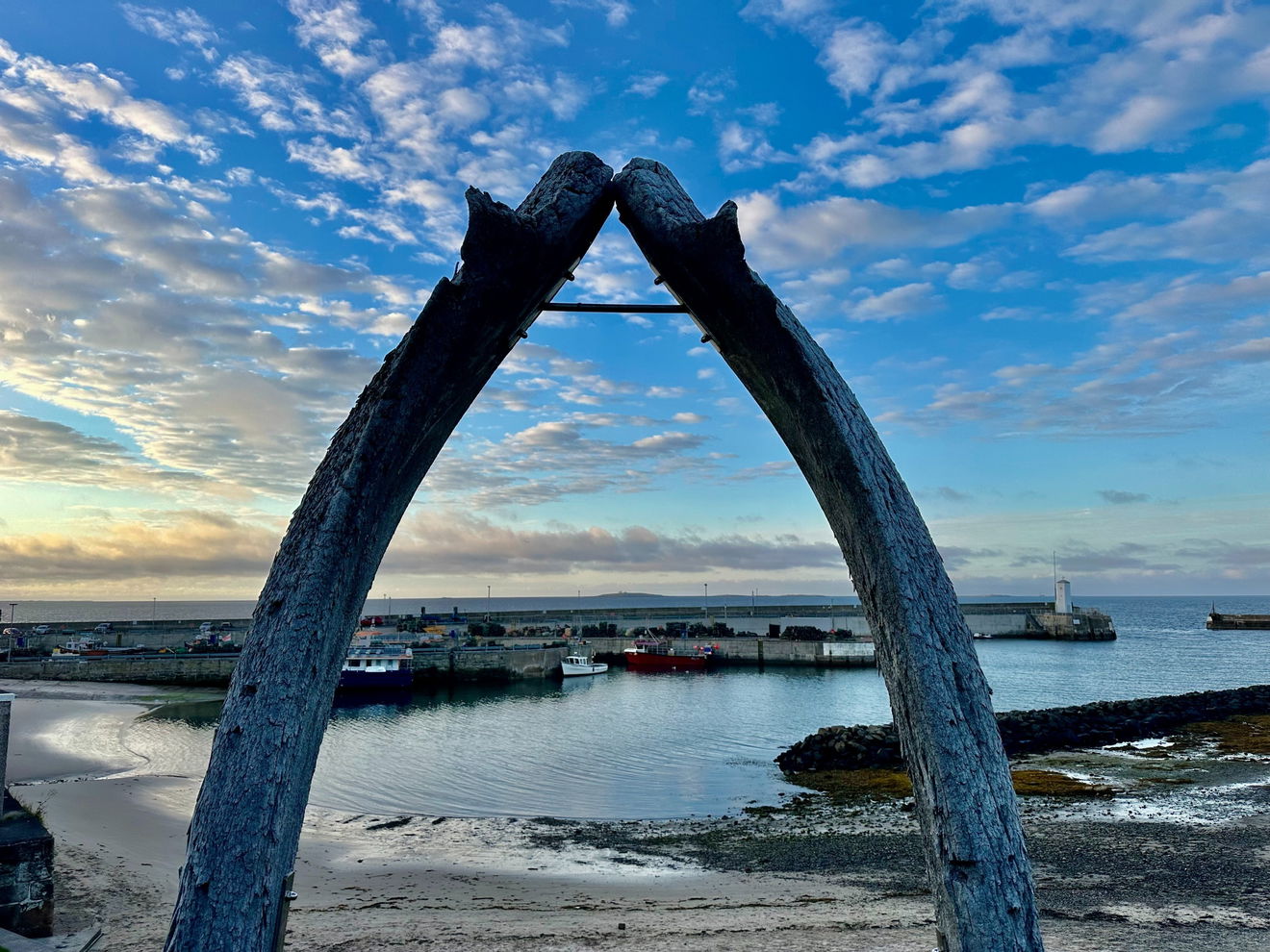
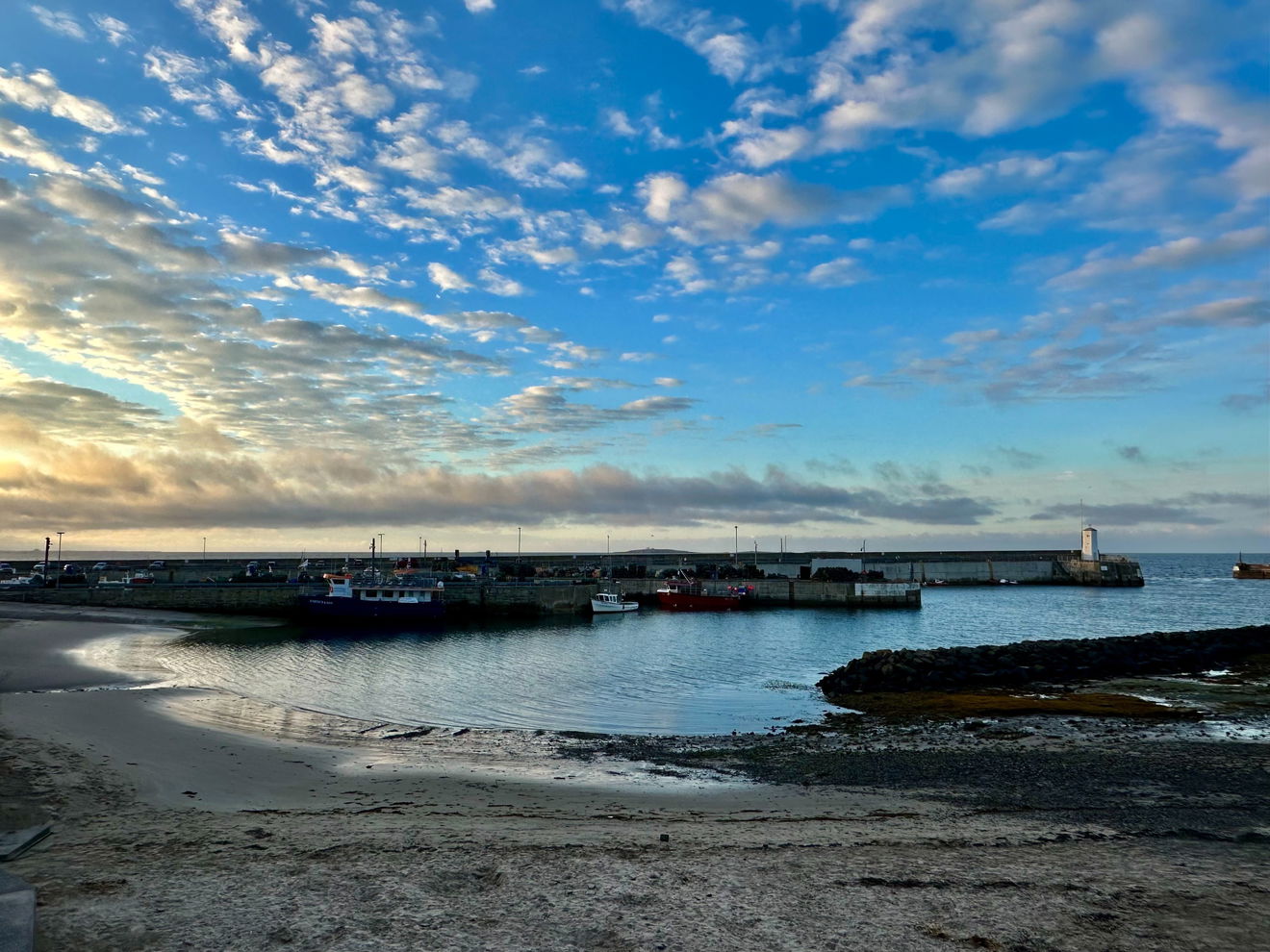
There's so much to see and do in this area of Northumberland. Why not find out about taking a trip to The Farne Islands to see the famous bird and seal colonies?
Just opposite the harbour in Seahouses at the junction of Harbour Road and Crewe Street.
Right Whales can grow to 16 metres in length and weigh up to 70,000 kilograms. They were so named by fishermen because they were seen as 'the right whales to hunt'. These whales are slow swimming, found close to shore and therefore an easy target, with the added fact that they floated once killed, so without the need to haul them aboard a boat. They offered an abundance of oil and baleen and were hunted near to extinction until the culling of these huge mammals was officially banned in 1935.
They were mysteriously stolen when it was suggested they should be removed from the grounds of a primary school and put in a more public position.
They miraculously turned up some months later when they were found at the gates of the local football ground!
Get 2 points if you have visited this place. Already visited by 122 VIPs.
Login to the VIP area to add places to your bucket list, mark them as visited and more importantly see where you rank on the league table.
How To Find Seahouses Right Whale Jaw Bones
Where Is Seahouses Right Whale Jaw Bones?
Lat / Long
55.581784, -1.650386
What three words
Where To Park For Seahouses Right Whale Jaw Bones?
Lat / Long
55.583212, -1.652102
What three words
Parking is available on the opposite side of the harbour near the boat excursion offices.
Contributed by Jos Forester-Melville
Highland loving human. Thalassophile. I love a good smile. Happiest heading for the hills with my pickup filled with kids and dogs! Working four days, we enjoy a Fridate, and usually spend it scouting out new scenery. I love a gated track, a bit of off roading and if it involves a full ford, well, that gets extra points! I go nowhere without a flask and binoculars, and love the small things in life that make it big…Goldcrests, dry stone walls, Deadman’s fingers, blackberries and quality clouds.
More Places from Jos
More Places In Seahouses
Find more fabulous places in Seahouses, Northumberland and if you know of a place we haven't listed, then let us know.
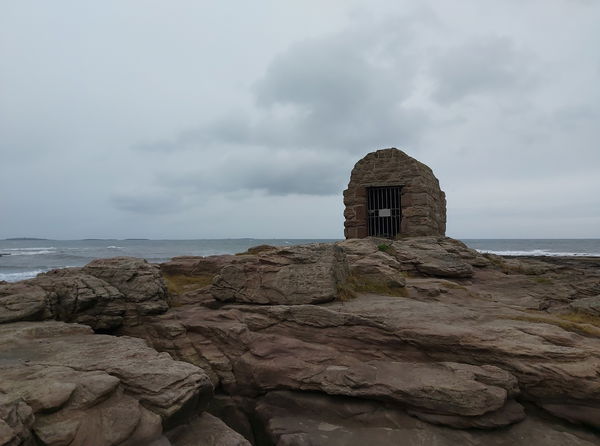
Gunpowder House
Building Seahouses NorthumberlandA small stone building used to store the explosives during the construction of the seahouses pier and harbour.
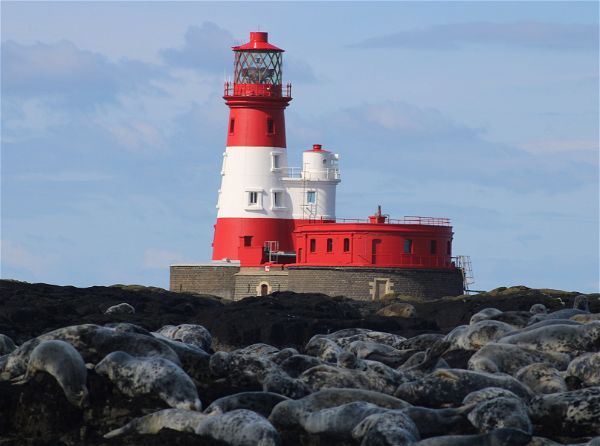
The Farne Islands
Landscape Seahouses NorthumberlandGroup of islands off the coast of Northumberland.
More Landmarks
So this landmark wasn't enough and you want more? Don't worry we have you covered.
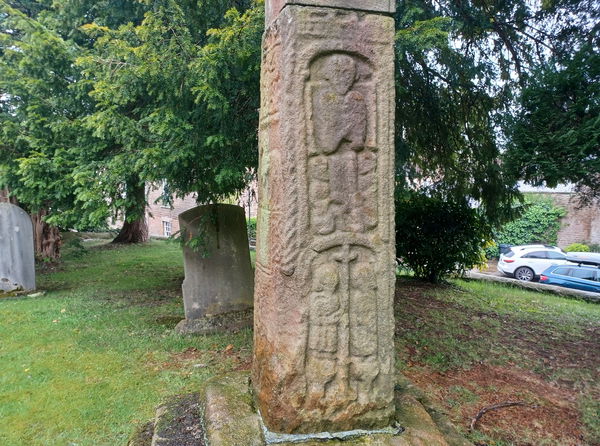
The Sigurd's Cross
Landmark Lancaster LancashireAncient Viking Cross dated between 865 and 950 in the graveyard of St Wilfrid's Church.

Whale Bone Arch
Landmark Whitby North YorkshireThe jaw bones of a whale as a reminder of the whaling industry of Whitby.

Bombardment Garden
Landmark Whitby North YorkshireA garden to look like a bombed house, as a memorial to the 1914 coastal attack.
Never Miss A Fabulous Place
If you are afraid of missing out on all the fabulous places we post, or just want to be the first to know, then sign up to the Fabulous North.
Each week we will email you all the brand new places that we visit.
Sign Up To AlertsFind Us On Facebook
We post all our new places daily on our Facebook Groups page, so join the group today and be notified when we add a new place.
Join Our Facebook GroupSeahouses Right Whale Jaw Bones was listed in Landmark // Northumberland // Seahouses

